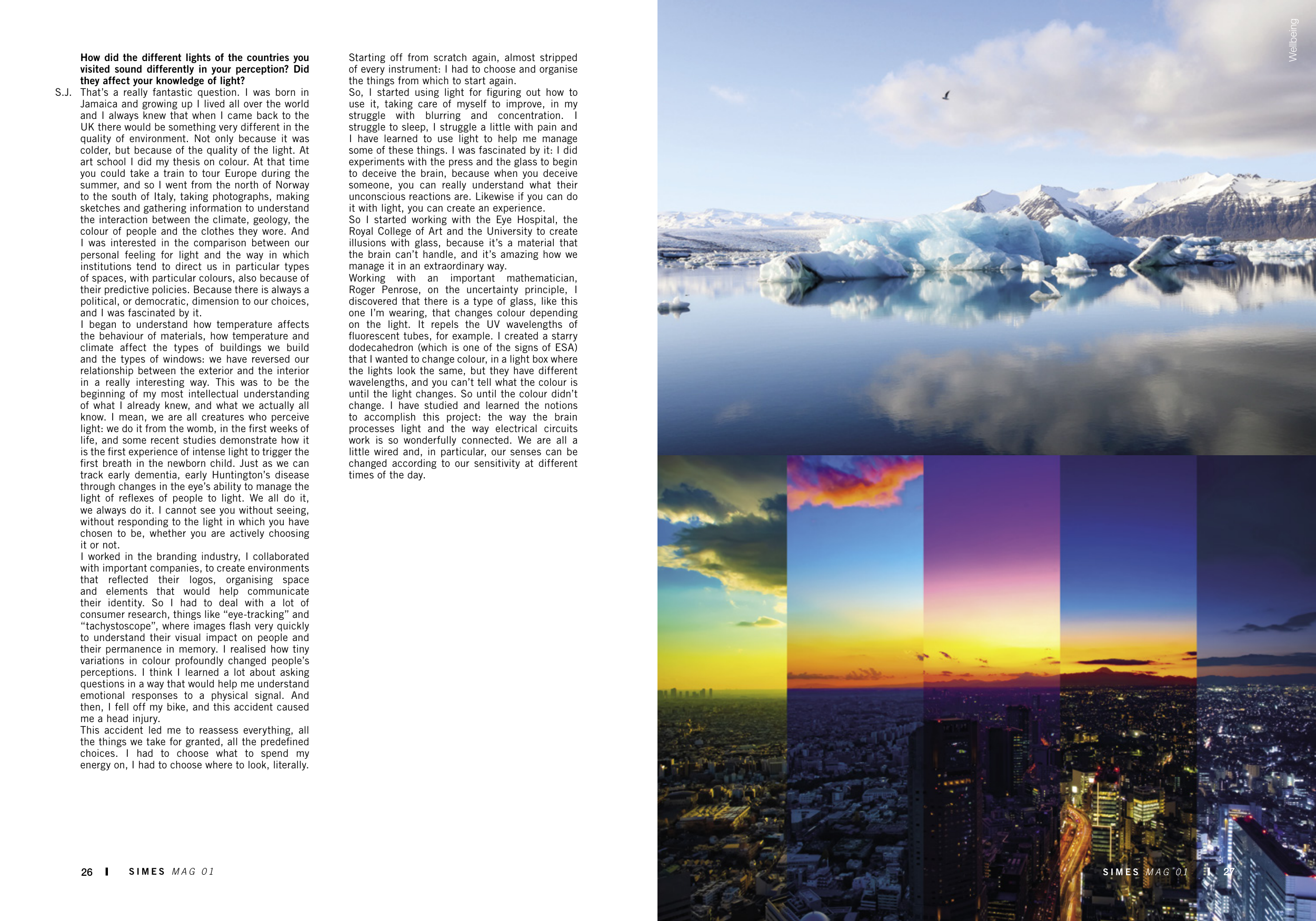Wellbeing
How did the different lights of the countries you
visited sound differently in your perception? Did
they affect your knowledge of light?
That’s a really fantastic question. I was born in
Jamaica and growing up I lived all over the world
and I always knew that when I came back to the
UK there would be something very different in the
quality of environment. Not only because it was
colder, but because of the quality of the light. At
art school I did my thesis on colour. At that time
you could take a train to tour Europe during the
summer, and so I went from the north of Norway
to the south of Italy, taking photographs, making
sketches and gathering information to understand
the interaction between the climate, geology, the
colour of people and the clothes they wore. And
I was interested in the comparison between our
personal feeling for light and the way in which
institutions tend to direct us in particular types
of spaces, with particular colours, also because of
their predictive policies. Because there is always a
political, or democratic, dimension to our choices,
and I was fascinated by it.
I began to understand how temperature affects
the behaviour of materials, how temperature and
climate affect the types of buildings we build
and the types of windows: we have reversed our
relationship between the exterior and the interior
in a really interesting way. This was to be the
beginning of my most intellectual understanding
of what I already knew, and what we actually all
know. I mean, we are all creatures who perceive
light: we do it from the womb, in the first weeks of
life, and some recent studies demonstrate how it
is the first experience of intense light to trigger the
first breath in the newborn child. Just as we can
track early dementia, early Huntington’s disease
through changes in the eye’s ability to manage the
light of reflexes of people to light. We all do it,
we always do it. I cannot see you without seeing,
without responding to the light in which you have
chosen to be, whether you are actively choosing
it or not.
I worked in the branding industry, I collaborated
with important companies, to create environments
that reflected their logos, organising space
and elements that would help communicate
their identity. So I had to deal with a lot of
consumer research, things like “eye-tracking” and
“tachystoscope”, where images flash very quickly
to understand their visual impact on people and
their permanence in memory. I realised how tiny
variations in colour profoundly changed people’s
perceptions. I think I learned a lot about asking
questions in a way that would help me understand
emotional responses to a physical signal. And
then, I fell off my bike, and this accident caused
me a head injury.
This accident led me to reassess everything, all
the things we take for granted, all the predefined
choices. I had to choose what to spend my
energy on, I had to choose where to look, literally.
S.J.
Starting off from scratch again, almost stripped
of every instrument: I had to choose and organise
the things from which to start again.
So, I started using light for figuring out how to
use it, taking care of myself to improve, in my
struggle with blurring and concentration. I
struggle to sleep, I struggle a little with pain and
I have learned to use light to help me manage
some of these things. I was fascinated by it: I did
experiments with the press and the glass to begin
to deceive the brain, because when you deceive
someone, you can really understand what their
unconscious reactions are. Likewise if you can do
it with light, you can create an experience.
So I started working with the Eye Hospital, the
Royal College of Art and the University to create
illusions with glass, because it’s a material that
the brain can’t handle, and it’s amazing how we
manage it in an extraordinary way.
Working with an important mathematician,
Roger Penrose, on the uncertainty principle, I
discovered that there is a type of glass, like this
one I’m wearing, that changes colour depending
on the light. It repels the UV wavelengths of
fluorescent tubes, for example. I created a starry
dodecahedron (which is one of the signs of ESA)
that I wanted to change colour, in a light box where
the lights look the same, but they have different
wavelengths, and you can’t tell what the colour is
until the light changes. So until the colour didn’t
change. I have studied and learned the notions
to accomplish this project: the way the brain
processes light and the way electrical circuits
work is so wonderfully connected. We are all a
little wired and, in particular, our senses can be
changed according to our sensitivity at different
times of the day.
27
S I M E S M A G 0 1
26
S I M E S M A G 0 1


